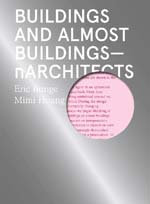
|

|
|
Home Site Search Contact Us Subscribe
|
|
Book Review on the Day of a Book Launch Party for nARCHITECTS "Buildings and Almost Buildings - nARCHITECTS" by Eric Bunge and Mimi Hoang wryly showcases their journey to create "near buildings." By Norman Weinstein May 21, 2019 Editor’s note: TONIGHT! The Book Launch Party for Buildings and Almost Buildings – nARCHITECTS, a panel discussion with Eric Bunge and Mimi Hoang, and led by Matt Shaw (The Architect’s Newspaper) and Andrés Jaque (Office for Political Innovation), is tonight (May 21) at nARCHITECTS-designed A/D/O, 29 Norman Avenue, Brooklyn, NY, 7:00-9:00 pm.
The trouble with much good architecture, or architecture books, is that even if they are masterpieces of some sort or another, they are bound. Fixed. So that even if there is an in-depth Post-Occupancy Evaluation or a book review that transcends press release summary, there is static fact and object. Nothing wrong there, but not enough right, if you experience your living as a daily journey of dynamically unfolding patterns. Which we are physically, whatever rewards exist for pretending otherwise. A question of what you value in architecture, and books, and daily living then, and if you value journeys of evolving patterns in flux, what Italo Calvino, grand literary fabulist, categorized as new millennium values, lightness, quickness, exactitude, visibility, and multiplicity, then you need nARCHITECTS, the firm founded by Eric Bunge and Mimi Hoang.
But if you’re without affluence to hire them for your next project, then you can buy their book, Buildings and Almost Buildings – nARCHITECTS (Actar, June 2019). And in this celebration of what they’ve done, here’s a gist. They’re witty. Really. An example? Read their account of designing A/D/O, a new Brooklyn design space that transformed a huge former warehouse. Refusing the conventional choices of slicing and dicing the warehouse into activity zones, or fashioning a large undifferentiated space, they created a flowing space where café, exhibition, and retail areas fluidly interpenetrated. Smart. But witty and wry? The original warehouse exterior was graffiti festooned brick. So, says Bunge and Hoang, “We removed graffiti-covered bricks, repurposing them to build new openings. Delighted with our invention, we called it ‘reconstituted graffiti.’ The local graffiti artists have not appreciated our subtlety, and have returned to re-tag A/D/O without apparent sense of irony, covering their reconstituted art with new graffiti.”
Smiling? Serious business, architecture, and architecture books? Uniformly properly long-faced. Now you might wonder in a world of survival needs addressed by architecture, rightly not a laughing matter, why wit matters a wit? Because wit unhinges a slavish fixation upon any thing being one thing, makes transgressive gestures like graffiti transformational. That is why “near buildings,” a label insisted upon by Bunge and Hoang in their practice and book, radiates fresh thinking about what architecture is, but can become. A “near building” isn’t a pale imitation of something once substantial, like “near beer,” but a refusal of closure in favor of continuous attentiveness to the present.
Meaning: architectural boundaries get redefined to fit this era redolent with new materials, new multi-dimensional building purposes, new environmental pressures and opportunities, insides and outsides racing through a Mobius strip. And as much as any architectural firm’s trajectory can be book bound, text has to slyly present bemused myriad voices, bemused while being alert and optimistic in this new Dark Ages, so the book’s cover is a shiny mirror finish with a circular cut. So you see yourself reflected loving architecture’s promise of utter flex and flux. And still on a surface there’s a gap where there’s a muse of deep architectural imaginings. It bids you enter this text with the thrill associated with entering near-perfect architecture.
Norman Weinstein is the author of “Words That Build” – an exclusive 21-part ArchNewsNow.com series about writing as a keystone of a successful architectural practice. He's authored several books of poetry and books about music and literature. Weinstein is currently learning weaving in order to deepen his understanding of architecture, music, and poetry. He can be reached at nweinstein25@gmail.com.
More by Weinstein:
Weinstein: From Ada to Zaha and Everything In Between Op-eds, book reviews, musings, and debate.
An exclusive 21-part series that focuses on the overlooked foundations of architecture: oral and written communication.
Most recent:
Best Bauhaus Books to
Peruse During the Bauhaus Centenary
Best
Architecture and Design Books of 2018
Writing About Architecture As If Only Art Matters A new coffee table book about Frederic Church's Olana combines resplendent photography with essays reflecting architectural myopia.
Welcome New Books Reveal the Heart of the Matter in Architectural Design Kenneth Frampton's new edition of Kengo Kuma's works, along with Kate Franklin and Caroline Till's global survey of novel thinking about sustainable materials, offer new slants on how materials matter.
Educating Future Architects to Think Like Curious Clients Expanding architectural education to include more about client consciousness is a key to enriching the profession.
Architectural Education at the Crossroads? Educators Duo Dickinson and Phil Bernstein look in opposite directions when assessing architecture school quality - but the next architecture school transformation may emerge from where no one is looking.
|
(click on pictures to enlarge)  Actar “Buildings and Almost Buildings – nARCHITECTS” by Eric Bunge and Mimi Hoang |
© 2019 ArchNewsNow.com